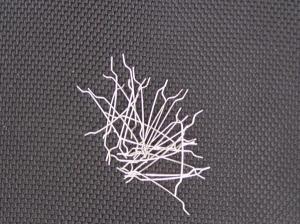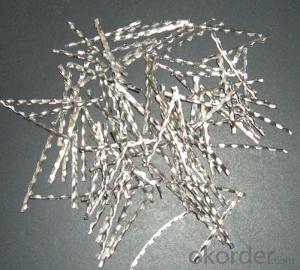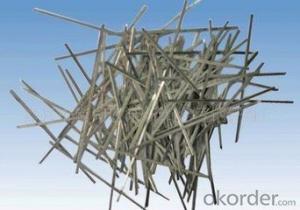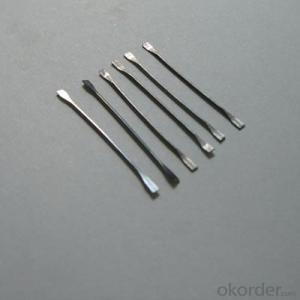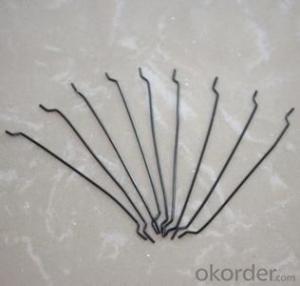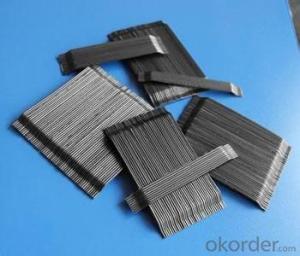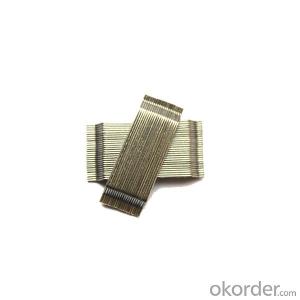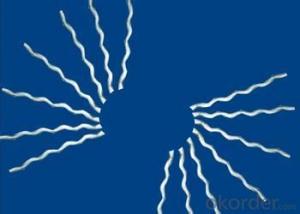Slit Sheet Stainless Steel Fiber 330
- Loading Port:
- China Main Port
- Payment Terms:
- TT or L/C
- Min Order Qty:
- 5 Tons m.t.
- Supply Capability:
- 5000 Tons per Month m.t./month
OKorder Service Pledge
OKorder Financial Service
You Might Also Like
General Information of Slit Sheet Stainless Steel Fiber 330
CMAX cold drawn stainless steel fiber is manufactured by high quality stainless steel wire, mainly used for castable requirements in refractory field, with high tensile strength and low ductility. It can improve refractory performance. Our products can save labor costs.
CMAXmelt extract stainless steel fibercan improve refractories performance and durability, decreasing cost.
CMAX Slit Sheet Stainless Steel Fiber 330 has good performance with the following characteristics:
Light weight
Improve refractories’ performance
Improve refractories’ longevity
Improve refractories’ durability
Significantly reducing downtime and maintance cost

CMAX Slit Sheet Stainless Steel Fiber 330 is available in a wide variety of application:
Refractory products
Precast
Castable project
Industrial furnaces
Other refractories project


Our steel fiber is widely used in the world.Our company has success in its melt extract stainless steel fiberproducts due to their cost-effectiveness and excellent insulating properties. We also have experience in melt extract stainless steel fiberapplication and would like to assist you in product selection, system design, and installation techniques. We can serve the good quality of melt extract stainless steel fiber, We look forward to your cooperation .
- Q:Can melt extract stainless steel fiber be used in railway sleepers?
- Certainly, melt extract stainless steel fiber is applicable for utilization in railway sleepers. Known for its exceptional resistance to corrosion and fatigue, stainless steel fiber serves as a robust material. By incorporating it into railway sleepers, the overall strength and longevity of the sleepers are significantly enhanced, rendering them suitable for heavy train loads and extended service life. The melt extract process guarantees the uniform and consistent shape of the stainless steel fibers, thereby further augmenting their performance and dependability. Moreover, the utilization of stainless steel fiber aids in the prevention of crack formation and improves resistance to thermal expansion and contraction, making it an ideal selection for railway sleepers.
- Q:Can melt extract stainless steel fiber be used in tunnel shotcrete lining applications?
- Absolutely, tunnel shotcrete lining applications can utilize melt extract stainless steel fiber. This particular fiber is widely employed to augment the mechanical characteristics of shotcrete, including tensile strength, flexural strength, and impact resistance. Moreover, the inclusion of melt extract stainless steel fibers can elevate the durability and longevity of shotcrete, rendering it ideal for tunnel applications where sustained performance is of utmost importance. Typically, these fibers are blended into the shotcrete mixture, thereby strengthening the overall structural integrity of the tunnel lining. All in all, melt extract stainless steel fibers present a dependable and efficient option for reinforcing tunnel shotcrete linings.
- Q:How does melt extract stainless steel fiber improve the durability of tunnel linings?
- Enhanced reinforcement and resistance to deterioration are achieved in tunnel linings through the use of melt extract stainless steel fiber. Micro-reinforcement is provided by these stainless steel fibers when they are added to the concrete mixture used for tunnel linings, resulting in improved strength and durability for the structure. The ability of melt extract stainless steel fiber to enhance the tensile strength of the concrete is a significant benefit. Tunnels experience various forces and stresses, such as ground movement, vibrations, and water pressure. By reinforcing the concrete with stainless steel fibers, the tunnel linings become more resistant to cracking and spalling, which could compromise the integrity of the structure. In addition, the corrosion-resistant properties of stainless steel fibers make them ideal for tunnel applications. Tunnels often face harsh environments, including high humidity, chemical exposure, and saltwater intrusion. These conditions can lead to the corrosion of the reinforcement within the concrete, resulting in degradation and reduced durability. However, the corrosion resistance of stainless steel fibers helps prevent this deterioration, ensuring that the tunnel linings remain structurally sound for a longer period. Furthermore, melt extract stainless steel fibers reduce the risk of fire damage, thus improving the durability of tunnel linings. Tunnels are susceptible to fire incidents, which can significantly weaken the concrete and compromise the safety of the structure. The stainless steel fibers serve as a reinforcement that can withstand high temperatures, preventing the concrete from rapidly losing its strength during a fire. This increased fire resistance enhances the overall durability and safety of the tunnel linings. In conclusion, melt extract stainless steel fiber enhances the durability of tunnel linings by improving tensile strength, corrosion resistance, and fire resistance. By reinforcing the concrete and protecting it from cracking, corrosion, and fire damage, these stainless steel fibers ensure that tunnel linings can withstand the various challenges they may encounter, ultimately extending their lifespan and enhancing the overall safety of the tunnels.
- Q:What is the effect of melt extract stainless steel fiber on the flexural toughness of concrete?
- The addition of melt extract stainless steel fiber to concrete has a positive effect on the flexural toughness of the material. The fibers act as reinforcement, increasing the overall strength and resistance to cracking or failure under bending or flexural forces. This leads to improved durability and increased load-bearing capacity of the concrete, making it more suitable for applications where flexural strength is crucial.
- Q:Can melt extract stainless steel fiber be used in lightweight concrete?
- Yes, melt extract stainless steel fiber can be used in lightweight concrete. Stainless steel fiber is added to concrete to enhance its mechanical properties, such as improving its tensile strength, flexural strength, and impact resistance. Lightweight concrete, on the other hand, is a type of concrete that incorporates lightweight aggregates or foaming agents to reduce its density and improve its thermal and acoustic properties. By adding melt extract stainless steel fiber to lightweight concrete, it can provide additional reinforcement and enhance its performance. The stainless steel fibers help to distribute the stresses more evenly throughout the concrete matrix, making it more resistant to cracking and improving its overall durability. Additionally, the use of stainless steel fibers can also increase the ductility of lightweight concrete, allowing it to better withstand dynamic loads and reduce the risk of sudden failure. In conclusion, melt extract stainless steel fiber is a suitable option for reinforcing lightweight concrete, as it can improve its mechanical properties and enhance its durability.
- Q:Can melt extract stainless steel fiber be used in airport runway pavements?
- Yes, melt extract stainless steel fiber can be used in airport runway pavements. This type of fiber offers excellent resistance to corrosion, high tensile strength, and enhanced durability. It can effectively enhance the mechanical properties and prevent cracking of the pavement, making it suitable for heavy-duty applications like airport runways.
- Q:Can melt extract stainless steel fiber be used in architectural precast elements?
- Indeed, architectural precast elements can make use of melt extract stainless steel fibers. These fibers are commonly incorporated into concrete mixes to enhance the strength, durability, and performance of the precast elements. During the batching process, the stainless steel fibers are typically added in small proportions by volume to the concrete mix. They serve to augment the flexural strength, impact resistance, and crack resistance of the precast elements. Moreover, the stainless steel fibers offer corrosion resistance, which is especially advantageous in architectural precast elements that may come into contact with severe environmental conditions or corrosive chemicals. In conclusion, the utilization of melt extract stainless steel fibers in architectural precast elements can yield structures of superior quality and prolonged lifespan.
- Q:Can melt extract stainless steel fiber be used in bridge decks or infrastructure projects?
- Yes, melt extract stainless steel fiber can be used in bridge decks or infrastructure projects. These fibers enhance the durability and structural strength of concrete, making it more resistant to cracking and improving its overall performance under heavy loads and harsh environmental conditions.
- Q:How does melt extract stainless steel fiber affect the cracking behavior of concrete?
- The cracking behavior of concrete is significantly impacted by melt extract stainless steel fiber. These fibers, produced by melting stainless steel and extracting it into varying lengths of fibers, are commonly used to reinforce concrete structures. Using melt extract stainless steel fiber has several benefits in enhancing the crack resistance of concrete. When added to the concrete mix, these fibers act as reinforcement, providing extra strength and preventing crack propagation. This is especially important for concrete structures that experience heavy loads or dynamic forces, as they are more prone to cracking. The presence of stainless steel fibers in concrete improves its tensile strength, which is usually lower than its compressive strength. Consequently, the concrete becomes more resistant to cracking as the fibers help distribute stress and prevent crack formation and propagation. This improved crack resistance is particularly advantageous in applications where concrete undergoes shrinkage, thermal expansion, or external loading, as it helps maintain the structure's integrity and durability. Furthermore, melt extract stainless steel fibers also improve the behavior of concrete after cracking. In conventional concrete, once a crack forms, it tends to spread rapidly, compromising structural integrity and reducing load-bearing capacity. However, with the addition of stainless steel fibers, these cracks are effectively bridged and restrained, reducing their width and preventing further propagation. This post-cracking behavior is crucial in maintaining the concrete's structural performance and serviceability under different loading conditions. In summary, melt extract stainless steel fiber has a significant impact on the cracking behavior of concrete by enhancing its crack resistance, tensile strength, and post-cracking behavior. By reinforcing the concrete matrix, these fibers prevent crack formation and propagation, improving the durability and structural integrity of concrete structures.
- Q:How does the addition of melt extract stainless steel fiber affect the drying time of concrete?
- The addition of melt extract stainless steel fiber can have a significant impact on the drying time of concrete. Stainless steel fibers are typically added to concrete mixtures to enhance its mechanical properties and improve its durability. One of the key advantages of using stainless steel fibers is their ability to reduce drying shrinkage. Concrete typically undergoes shrinkage as it dries, which can lead to cracks and other structural issues. The addition of stainless steel fibers helps to restrain this shrinkage, resulting in a more controlled and uniform drying process. The presence of stainless steel fibers also aids in the formation of a more interconnected network within the concrete matrix. This network enhances the concrete's resistance to cracking and improves its overall strength. As a result, the concrete can withstand forces and stresses better, even during the drying phase. Furthermore, stainless steel fibers also contribute to the reduction of plastic shrinkage cracking. This type of cracking occurs during the early stages of concrete drying, when the surface moisture evaporates faster than it can be replaced. By reinforcing the concrete, the stainless steel fibers help to mitigate this cracking, leading to a more efficient and stable drying process. In summary, the addition of melt extract stainless steel fiber can significantly affect the drying time of concrete. By reducing drying shrinkage, enhancing the concrete's mechanical properties, and mitigating cracking, the fibers contribute to a more controlled and efficient drying process, ultimately improving the overall performance and durability of the concrete structure.
1. Manufacturer Overview |
|
|---|---|
| Location | Henan, China |
| Year Established | 2007 |
| Annual Output Value | Above US$ 60 Million |
| Main Markets | Mid East; Eastern Europe; North America |
| Company Certifications | ISO 9001:2008 |
2. Manufacturer Certificates |
|
|---|---|
| a) Certification Name | |
| Range | |
| Reference | |
| Validity Period | |
3. Manufacturer Capability |
|
|---|---|
| a)Trade Capacity | |
| Nearest Port | Tianjin |
| Export Percentage | 31% - 50% |
| No.of Employees in Trade Department | 21-50 People |
| Language Spoken: | English; Chinese |
| b)Factory Information | |
| Factory Size: | Above 36,000 square meters |
| No. of Production Lines | Above 5 |
| Contract Manufacturing | OEM Service Offered |
| Product Price Range | Average |
Send your message to us
Slit Sheet Stainless Steel Fiber 330
- Loading Port:
- China Main Port
- Payment Terms:
- TT or L/C
- Min Order Qty:
- 5 Tons m.t.
- Supply Capability:
- 5000 Tons per Month m.t./month
OKorder Service Pledge
OKorder Financial Service
Similar products
New products
Hot products
Related keywords
